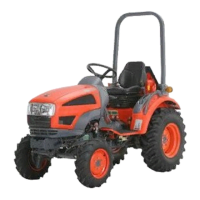CHAPTER 1 CK20(H)
1-26
S196-WOO Jul. 2003
a. Battery Charging
1. Make sure each electrolyte level is somewhere be-
tween the markings (A) and (B). Add a proper amount
of distilled water up to the highest level as required.
2. The water in the electrolyte evaporates during
recharging. Liquid shortage damages the battery.
Excessive liquid spills over and damages the trac-
tor body.
3. To slow charge the battery, connect the battery posi-
tive terminal to the charger positive terminal and
the negative to the negative, then recharge in the
standard fashion.
4. A boost charge is only for emergencies. It will par-
tially charge the battery at a high rate and in a short
time.
When using a boost-charged battery, it is neces-
sary to recharge the battery as early as possible.
Failure to do this will shorten the battery’s service
life.
5. When the specific gravity of electrolyte is between
1.27 and 1.29 the charging is completed.
6. When exchanging an old battery for a new one, use
battery of equal specification shown in table 1.
b. Table 1
Volts (v)
12
Tractor
model
CK20H
CK20
Battery
TYPE
70D23L
DF65D
Capacity at
20HR (A.H)
65
c. Direction for Storage
1. When storing the tractor for a long period, remove
the battery from tractor, adjust the electrolyte to the
proper level and store in a dry place out of direct
sunlight.
2. The battery self-discharges while it is stored.
Recharge it once every three months in hot sea-
sons and once every six months in cold seasons.
To avoid personal injury:
• When the battery is being activated, hydrogen and
oxygen gases in the battery are extremely
explosive. Keep open sparks and flames away
from the battery at all times, especially when
charging the battery.
• When charging the battery, ensure the vent caps
are securely in place. (If equipped)
• When disconnecting the cable from the battery,
start with the negative terminal first.
• When connecting the cable to the battery, start
with the positive terminal first.
• Never check battery change by placing a metal
object across the posts. Use a voltmeter or
hydrometer.
CAUTION

